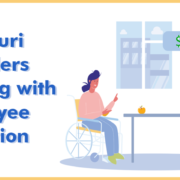Missouri Providers are Struggling with Employee Retention
Missouri workers providing care for adults with intellectual and developmental disabilities make less than a Walmart or Target worker, even after a pay increase that went into effect last month.
The low pay is the main reason about half of Missouri workers quit each year, according to Missouri Developmental Disabilities Division Director Val Huhn.
Starting wages now range between $9.50 and $10.50 an hour thanks to Missouri state lawmakers appropriating $20 million more in general revenue to providers. But advocates worry this isn’t enough to address the chronic worker turnover that affects the quality of care people with intellectual and developmental disabilities receive.
“It’s just devastating, not having that reliable staff,” Huhn says. “Can you imagine constantly training somebody on how to brush your teeth if you can’t do that? I mean, just you’re just constantly teaching people how to help you.”
Crisis levels
Travis Anderson has spent about a year trying to find a personal care assistant. He’s 45, has a disability, and uses a power wheelchair to get around.
Anderson works as a receptionist and self-directs his care, meaning he hires a worker and the state pays for it. While Anderson is looking, his aunt has stepped in. But she’s almost 70 and Anderson says he’s not sure how much longer she can do this. Travis Anderson interviewed five people for a personal care assistant job the day KCUR spoke with him. Anderson said once they found out the pay, none of them were interested.
Every time he thinks he’s found someone to hire, there’s an issue. Sometimes they can’t work the hours. Anderson needs help getting ready in the morning and then the worker would have to come back in the evening to help him get to bed. Other times they don’t pass the criminal background check.
Nationally, the direct support workforce has reached crisis levels, according to a 2017 report by the President’s Committee for People with Intellectual Disabilities.
“Not only does the crisis facing this workforce threaten people with intellectual disability and their families; it also undermines the stability, efficiency and ability to grow much needed long-term services and supports and, therefore, undermines the overall U.S. economy,” Jack Brandt, the committee’s chair, wrote.
It’s been almost a year since Anderson’s aunt said she could help out for three months. Without his aunt, Anderson doesn’t know what he would do. He says his service coordinator wants him to consider going to a nursing home.
“I don’t think I would fit very well into a nursing home,” Anderson says. “…When you envision how your life’s going to be, I mean, nursing home doesn’t even come up right now. But I’m really struggling to find good staff.”
The Developmental Disabilities Division doesn’t “encourage placements in nursing homes,” Debra Walker, the director of public affairs, said in an email. “ That being said, sometimes there are circumstances when a nursing home would be an appropriate placement.”
Walker said Anderson’s support coordinator is from a private organization and not a state worker. Walker said the state can’t speak to the specifics of the case, but generally, it’s “certainly important to have a support coordinator that is helpful and seeks out all the options.”
Anderson is two classes short of a bachelors degree in psychology but he said he’s had to put his future on hold.
“I can’t very well get back in school when I literally don’t know from week to week or month to month how I’m getting out of bed,” Anderson says. “I mean, you have to prioritize.”
“You have to really like this” Pagi Bowls and Rojai Morris both work at White Oaks, a residential home for people with developmental disabilities.CREDIT AVIVA OKESON-HABERMAN / KCUR 89.3
Rojai Morris got a pay raise because of the additional state funding. She works at White Oaks, a residential home for people with developmental disabilities. It’s run by the Center for Developmentally Disabled in Kansas City. CDD increased their starting wage for workers from $11 to $12.25.
The additional $1.25 an hour isn’t enough for Morris to quit her second job. Between her two jobs, she says she works 70 hours a week to get by. She says she loves her job but the long hours take a toll.
“It kind of makes you want to second guess working in this field,” Morris says. “Is this really for me because of what I’m going through? I’m only 21 so I kind of look at it like I’m stressing going through this now. Is this where I see my future?”
Nationally, high turnover has been an issue for decades but a strong economy means workers can make more money at less demanding jobs, according to Amy Hewitt, the director of the Institute on Community Integration at the University of Minnesota. Hewitt says an aging population also means workers are serving people with more complex needs.
“We continue to place higher expectations on this workforce,” Hewitt says. “So it really is a highly-skilled workforce. But we don’t talk about it that way. And we don’t support it as a highly-skilled workforce.”
“It’s heartbreaking”
David Earls took care of his son Edward, who is nonverbal, for about thirty years.
“I like to think of myself as one of the shallowest, insignificant, heartless people ever created until I started caring for my son,” Earls says. “And luckily, my son has an enormous amount of patience. And so he’s been working with me for 33 years now.”
Earls was getting older and he wanted to make sure Edward would be taken care of, so about three years ago, he moved Edward to a residential home. Almost immediately, he noticed issues with turnover.
“When you become attached or very fond of a staff member because you’ve seen this person interact with your son for three, four, five, six months, and then all of a sudden, they’re gone. It’s heartbreaking,” Earls says. “Because you know that there’s a relationship being formed there that positive for both Edward and the caregiver.”


